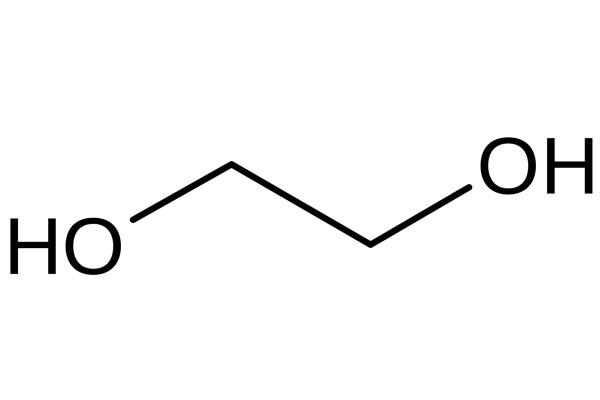Cas No: 107-21-1
EINESC No: 203-473-3
Molecular weight: 62.068 g/mol
Chemical Formula: C2H6O2
Chemical Structure:
Physical Properties
General Properties: colorless liquid
Odor: odorless
Intensity: 1,1132 gr/L
Boiling point: 230,5 °C
Melting point: −12,9 °C
Flash point: 197,3 °C
Vapor pressure: 0.06 mmHg 20 °C
Refraction index: 1,43 nD
Solubility (aqueous) completely miscible
pH: 5,5 – 8

General Properties
Ethylene glycol is an odorless, colorless, high viscosity liquid which is used in production of polyester fiber and antifreeze. It is sweet-ish. Whit it does not dissolve in oil derivitives, fat and some hydrocarbons, it dissolves in some chemicals such as water, glycerin, ketone and aldehyde.
Production
There is more than one method to industrially produce ethylene glycol. In most commonly used method, production starts with producing oxide from ethylene to ethylene. Then, this ethylene oxide is put into reaction to acquire ethylene glycol. This reaction can be catalyzed in acidic or alkaline environments or it can be made in neutral environments with high temperatures.
Another way is the Omega method. In this method, ethylene oxide is first turned into ethylene carbonate via carbon doxide then it is turned into mono ethylene glycol in presence of a alcali catalyst. This method is more selective and fruitful.
Lastly, ethylene glycol can be produced via carbon monoxide. This method is preferred in countries that have less environment regulations and high coal deposits.
Applications
Monoethyleneglycol has a wide array of uses. It is very good as heat transferring agent and it has its uses in many fields, thank to this property. Although it is not preferred in some countries due its hazardous nature for human health, it s preferred in many chemical productions from antifreeze to computer cooler. It is a commonly used icing inhibitor for planes and airport runways. It also prevents corrosion when used in motors as antifreeze. It is also used as antifreeze for dyes. It gives slickness and ease of application to dyes.
It is also used as raw material for polyethylene terephthalate production. It works as raw material in polyester fibre and some resin productions. It is preferred in some printing machines for its high boiling point.
Safety Measures and Toxic Levels
Ethylene glycol’s oral LD value is 786mg/kg and it is moderately toxic for humans. The biggest reason for its danger is that it is sweet. It poses a great danger for kids and animals. When swallowed, it oxidizes into oxalic acid which is a toxic substance. If swallowed in certain amounts, it affects neural system, heart and kidneys and, if not treated, can be fatal. Therefore, in some countries, it is compulsory to add denatonium benzoate, also used in denature alcohol, to decrease its sweetness.
Ethylene glycol is a chemical that has large production capacity and it decays on air in approximately 10 days, and a couple of weeks in water and soil. Above certain doses, it is also hazardous for animals.